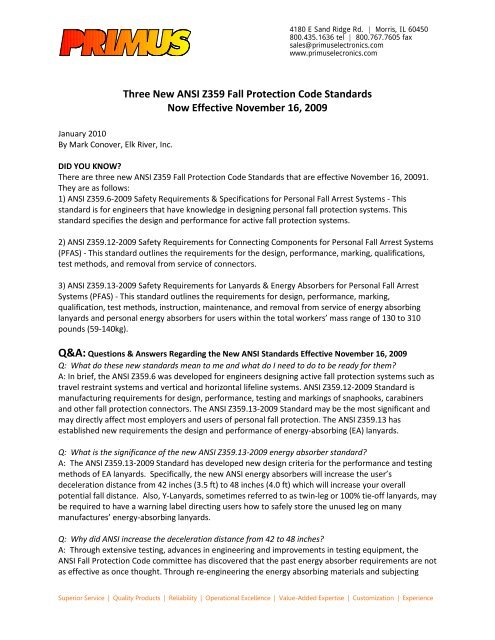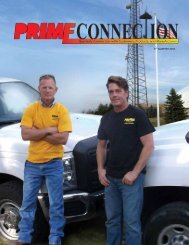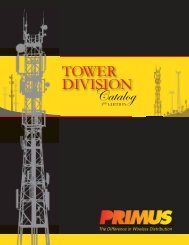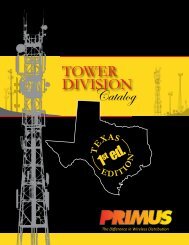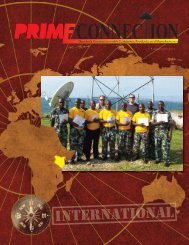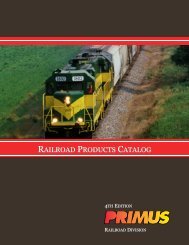Three New ANSI Z359 Fall Protection Code Standards - Primus ...
Three New ANSI Z359 Fall Protection Code Standards - Primus ...
Three New ANSI Z359 Fall Protection Code Standards - Primus ...
You also want an ePaper? Increase the reach of your titles
YUMPU automatically turns print PDFs into web optimized ePapers that Google loves.
4180 E Sand Ridge Rd. | Morris, IL 60450<br />
800.435.1636 tel | 800.767.7605 fax<br />
sales@primuselectronics.com<br />
www.primuselecronics.com<br />
January 2010<br />
By Mark Conover, Elk River, Inc.<br />
<strong>Three</strong> <strong>New</strong> <strong>ANSI</strong> <strong>Z359</strong> <strong>Fall</strong> <strong>Protection</strong> <strong>Code</strong> <strong>Standards</strong><br />
Now Effective November 16, 2009<br />
DID YOU KNOW?<br />
There are three new <strong>ANSI</strong> <strong>Z359</strong> <strong>Fall</strong> <strong>Protection</strong> <strong>Code</strong> <strong>Standards</strong> that are effective November 16, 20091.<br />
They are as follows:<br />
1) <strong>ANSI</strong> <strong>Z359</strong>.6-2009 Safety Requirements & Specifications for Personal <strong>Fall</strong> Arrest Systems - This<br />
standard is for engineers that have knowledge in designing personal fall protection systems. This<br />
standard specifies the design and performance for active fall protection systems.<br />
2) <strong>ANSI</strong> <strong>Z359</strong>.12-2009 Safety Requirements for Connecting Components for Personal <strong>Fall</strong> Arrest Systems<br />
(PFAS) - This standard outlines the requirements for the design, performance, marking, qualifications,<br />
test methods, and removal from service of connectors.<br />
3) <strong>ANSI</strong> <strong>Z359</strong>.13-2009 Safety Requirements for Lanyards & Energy Absorbers for Personal <strong>Fall</strong> Arrest<br />
Systems (PFAS) - This standard outlines the requirements for design, performance, marking,<br />
qualification, test methods, instruction, maintenance, and removal from service of energy absorbing<br />
lanyards and personal energy absorbers for users within the total workers’ mass range of 130 to 310<br />
pounds (59-140kg).<br />
Q&A: Questions & Answers Regarding the <strong>New</strong> <strong>ANSI</strong> <strong>Standards</strong> Effective November 16, 2009<br />
Q: What do these new standards mean to me and what do I need to do to be ready for them?<br />
A: In brief, the <strong>ANSI</strong> <strong>Z359</strong>.6 was developed for engineers designing active fall protection systems such as<br />
travel restraint systems and vertical and horizontal lifeline systems. <strong>ANSI</strong> <strong>Z359</strong>.12-2009 Standard is<br />
manufacturing requirements for design, performance, testing and markings of snaphooks, carabiners<br />
and other fall protection connectors. The <strong>ANSI</strong> <strong>Z359</strong>.13-2009 Standard may be the most significant and<br />
may directly affect most employers and users of personal fall protection. The <strong>ANSI</strong> <strong>Z359</strong>.13 has<br />
established new requirements the design and performance of energy-absorbing (EA) lanyards.<br />
Q: What is the significance of the new <strong>ANSI</strong> <strong>Z359</strong>.13-2009 energy absorber standard?<br />
A: The <strong>ANSI</strong> <strong>Z359</strong>.13-2009 Standard has developed new design criteria for the performance and testing<br />
methods of EA lanyards. Specifically, the new <strong>ANSI</strong> energy absorbers will increase the user’s<br />
deceleration distance from 42 inches (3.5 ft) to 48 inches (4.0 ft) which will increase your overall<br />
potential fall distance. Also, Y-Lanyards, sometimes referred to as twin-leg or 100% tie-off lanyards, may<br />
be required to have a warning label directing users how to safely store the unused leg on many<br />
manufactures’ energy-absorbing lanyards.<br />
Q: Why did <strong>ANSI</strong> increase the deceleration distance from 42 to 48 inches?<br />
A: Through extensive testing, advances in engineering and improvements in testing equipment, the<br />
<strong>ANSI</strong> <strong>Fall</strong> <strong>Protection</strong> <strong>Code</strong> committee has discovered that the past energy absorber requirements are not<br />
as effective as once thought. Through re-engineering the energy absorbing materials and subjecting<br />
Superior Service | Quality Products | Reliability | Operational Excellence | Value-Added Expertise | Customization | Experience
4180 E Sand Ridge Rd. | Morris, IL 60450<br />
800.435.1636 tel | 800.767.7605 fax<br />
sales@primuselectronics.com<br />
www.primuselecronics.com<br />
these materials to a battery of dynamic tests, a new standard was developed. This new standard will<br />
decrease the deceleration forces, to approximately 900 pounds in a 6 foot free fall and fall arrest,<br />
particularly in the upper reaches of the weight range where the previous standard fell short.<br />
Q: Why is a warning label required on some energy-absorbing Y-Lanyards (100% tie-off)?<br />
A: If the unused leg of some energy-absorbing Y-Lanyards is parked on a hip D-ring during a fall, arrest<br />
forces of the fall may be transferred to the hip D-ring. This may cause injury to the user. There is a<br />
simple solution to avoiding this issue in most cases. If you have a lanyard park or clip located at or near<br />
your chest strap on your harness, you can attach the unused leg to the lanyard park. This will shorten<br />
the distance between your unused snaphook and the fall arrest D-ring which will prevent potential<br />
injury from the unused lanyard leg.<br />
Q: Do I have to throw out my old energy-absorbing (EA) lanyards and replace it with new energyabsorbing<br />
(EA) lanyards after November 16, 2009?<br />
A: The <strong>ANSI</strong> <strong>Z359</strong>.13-2009 Standard is a voluntary Standard so you are not required by law or OSHA<br />
Regulation to replace your existing equipment. However, many companies may want to take a proactive<br />
approach and update their fall protection immediately to the Standard of greatest consequence. At the<br />
very least you will want to replace your equipment, as it is removed from service, with the energyabsorbing<br />
lanyards meeting the <strong>ANSI</strong> <strong>Z359</strong>.13-2009 Standard.<br />
Q: Will I be safe using the old standard energy-absorbing (EA) lanyard?<br />
A: If you have inspected and use your EA lanyard as recommended by the manufacturer, you should be<br />
fine. However, if the total worker mass or capacity rating (body plus tools and equipment total weight) is<br />
above 250 pounds and not exceeding 310 pounds, you may want to consider replacing his present EA<br />
lanyard. In effect, the standard change has reduced the deceleration forces to approximately 900 lbs on<br />
the body, in a 6 foot free fall, only in the higher reaches of the capacity rating. For all others (130-249<br />
lbs) the deceleration forces remain the same, at or below 900 lbs as the previous standard, in a 6 foot<br />
free fall. The new <strong>ANSI</strong> <strong>Z359</strong>.13-2009 Standard covers the same capacity rating as it has in the past - 130<br />
to 310 pounds (59-140 kg).<br />
Q: I just bought a new energy-absorbing (EA) lanyard with 3,600 pound gate snaphooks. Will I have to<br />
go out and replace my new lanyard by November 16th even though it is in good condition?<br />
A: No, you will not have to replace your present EA lanyard if it has been inspected to be in good<br />
condition. In fact, fall protection manufacturers and distributors will have existing EA lanyard inventories<br />
to sell beyond the new standard date. As manufacturers’ and distributors’ inventory cycle through new<br />
standard product will become available. Though the <strong>ANSI</strong> <strong>Z359</strong> <strong>Fall</strong> <strong>Protection</strong> <strong>Code</strong> is a voluntary<br />
standard, manufacturers are ethically required to assemble EA lanyards to the new standard beginning<br />
November 16th and will no longer produce to the old standard. When you are ready to buy a<br />
replacement EA lanyard, you will want to buy an EA lanyard marked <strong>ANSI</strong> <strong>Z359</strong>.1-2007 or the <strong>ANSI</strong><br />
<strong>Z359</strong>.13-2009.<br />
Q: Does the new <strong>ANSI</strong> <strong>Z359</strong>.13-2009 energy-absorbing (EA) lanyard require 3,600 pound gate strength<br />
snaphooks?<br />
A: Yes, all <strong>ANSI</strong> <strong>Z359</strong> lanyards, manufactured since November 24, 2007, are required to have the<br />
minimum 3,600 pound gate strength snaphooks.<br />
Superior Service | Quality Products | Reliability | Operational Excellence | Value-Added Expertise | Customization | Experience
4180 E Sand Ridge Rd. | Morris, IL 60450<br />
800.435.1636 tel | 800.767.7605 fax<br />
sales@primuselectronics.com<br />
www.primuselecronics.com<br />
Q: I am a steel erector and I have to tie-off at my feet. Can I use the new <strong>ANSI</strong> energy-absorbing (EA)<br />
lanyard for this application?<br />
A: <strong>ANSI</strong> has a special solution for free fall applications greater than 6 feet but not to exceed 12 feet. This<br />
special application energy-absorbing lanyard is designed the worker with a weight mass of 130-310<br />
pounds (59-140 kg). This particular EA lanyard is required to have special markings to bring singular<br />
attention to the user and its unique application. The label is required to be black in color with white<br />
print. This EA lanyard cannot be used as a dual purpose (6 foot and 12 foot free fall) lanyard regardless<br />
of weight range of the user. No EA lanyard can be used in a 6 foot and a 12 foot free fall situation<br />
interchangeably.<br />
Q: Is deceleration distance the same in the 12 foot free fall energy-absorbing lanyard as the 6 foot free<br />
fall energy-absorbing lanyard?<br />
A: No, they are different. The 12 foot free fall personal energy absorber has a maximum deceleration<br />
distance of 60 inches (5 ft.). Once again, it is imperative the user calculate the total potential fall<br />
distance or clearance needed when using the 12 foot free fall personal energy-absorbing lanyard.<br />
Q: How much clearance would be needed for the 12 foot free fall personal energy-absorbing lanyard?<br />
A: The 12 foot free fall (FF) personal energy-absorbing lanyard will require the user to calculate a<br />
clearance from the anchor point to the obstructions, equipment, and/or the ground below of<br />
approximately 20 feet. This calculation includes a 3 foot safety factor. When comparing the identical<br />
work space of a potential fall arrest for a 6 foot FF vs. 12 foot FF, the 12 foot FF would require<br />
approximately 7’ additional clearance below the worker (additional 6 foot FF plus 1 foot energy<br />
absorber deployment). Consult your Competent Person or safety professional when calculating your<br />
potential fall distance and circumstances specific to your worksite.<br />
Q: I have a worker that exceeds the <strong>ANSI</strong> capacity of 310 lbs. What energy-absorbing lanyard can I use<br />
for him?<br />
A: At this time <strong>ANSI</strong> considers anyone over 310 pounds to be<br />
outside the scope of this Standard. The thought process behind the <strong>ANSI</strong> Committee’s decision to<br />
exclude heavy workers (over 310 lbs.) was the unknown physical effects of a fall, suspension, and rescue<br />
time of the heavy workers following a fall. The capacity or strength of fall protection equipment was<br />
never an issue. There is not enough research in the area of fall arrest and suspension trauma, as well as<br />
rescue time, with the heavy worker at the present time.<br />
Q: How can <strong>ANSI</strong> deviate from the OSHA standard stating that a shock absorber must be 42 inches and<br />
not exceed 900 pounds of force on the worker, and will I be in violation with OSHA?<br />
A: No, you will not be in violation with OSHA by following the new <strong>ANSI</strong> <strong>Z359</strong>.13 Standard. OSHA has a<br />
policy of issuing “de minimis” notices to employers who comply with more current versions of<br />
consensus standards, to the extent that the more current versions are at least as protective as the older<br />
versions. The OSHA “de minimis” notices allow consensus standards, such as <strong>ANSI</strong>, to develop standards<br />
with new technologies that advance safety in the workplace.<br />
http://www.dol.gov/federalregister/Search/GetHtml.aspx?DocID=10157<br />
Q: Does the <strong>ANSI</strong> <strong>Z359</strong> Standard <strong>Fall</strong> <strong>Protection</strong> <strong>Code</strong> affect to the construction industry?<br />
A: No, the <strong>ANSI</strong> <strong>Z359</strong> Standard affects General Industry only. However, you may want to use fall<br />
protection products manufactured to this Standard due to the increased security of the 3,600 lb gate<br />
strength and personal energy absorber changes that may positively affect your company’s fall protection<br />
Superior Service | Quality Products | Reliability | Operational Excellence | Value-Added Expertise | Customization | Experience
4180 E Sand Ridge Rd. | Morris, IL 60450<br />
800.435.1636 tel | 800.767.7605 fax<br />
sales@primuselectronics.com<br />
www.primuselecronics.com<br />
program.<br />
Mark Conover, a member of the <strong>ANSI</strong> <strong>Z359</strong> <strong>Fall</strong> <strong>Protection</strong> <strong>Code</strong> committee, is general manager of Elk<br />
River, Inc. in Cullman, Alabama. Elk River is a leading manufacturer of personal fall protection products<br />
and rescue equipment in North America. For more information about Elk River, visit www.elkriver.com.<br />
1Reference used: American Society of Safety Engineers website. http://www.asse.org/newsroom/release.php?pressRelease=1292<br />
Superior Service | Quality Products | Reliability | Operational Excellence | Value-Added Expertise | Customization | Experience


